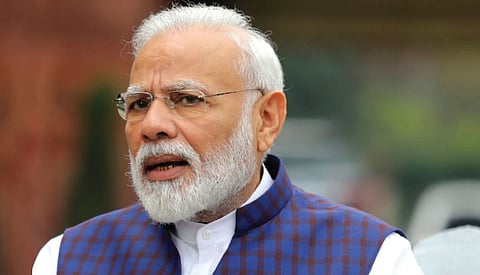
- Home
- About
- Globally Speaking
- Videos
- Podcast
- Geopolitics
- Industry
- SIGN UP

Modi's ′One Sun One World One Grid (OSOWOG) vision moves India onto the centre stage globally, accelerating the energy system decarbonisation to help solve climate change.
Prime Minister Narendra Modi has announced a new ′One Sun One World One Grid' (OSOWOG) vision for India to replicate its global solar leadership by encouraging the phased development of a single globally connected electricity grid to leverage the multiple benefits of ever lower cost renewable energy. International grid connectivity builds a win-win outcome. Countries like India have huge natural renewable energy resources so win from accelerated investment in low cost, zero pollution sustainable energy, with increased scale driving electricity deflation faster.

The national grid benefits from a greater ability to integrate low cost but intermittent renewable energy, exporting surplus low cost renewable energy at times of peak generation, while at the same time building capacity to import electricity (say from Bhutan hydro) at times of peak evening demand, when the sun has set.
From India's current position relying on some $250 billion of fossil fuel imports annually (oil, diesel, LNG, coking and thermal coal), India can look to develop sustainable renewable energy exports, improving the current account deficit and reducing imported inflation pressures. More renewable energy means reduced water scarcity, plus less particulate and air pollution. Global investors have shown a clear propensity to invest in India's renewable energy ambitions, and the supporting grid infrastructure needed. And for an added benefit, India moves onto centre stage globally, accelerating the energy system decarbonisation to help solve the global climate crisis that India did not create.

The idea of an internationally connected electricity grid is not new. Decades ago the Europeans launched Desertec to leverage the vast natural resources of Northern Africa as a supply of zero emissions solar and wind energy to Europe, with futuristic plans of subsea cables from Morocco to Gibraltar, and Tunisia to Sicily then Italy.
Only with the advent of learning by doing at industrial scale of offshore wind deployments in the North Sea has the cost and capacity of subsea electricity cabling been proven, at ever increasing capacities whilst unit costs have dramatically reduced.
The technology for high voltage direct current (HVDC) cabling has advanced phenomenally over the last decade. The North Sea Network Link between Norway and the UK is a 1,400MW, 515kV, 730 km connection due for completion in 2021, with cable manufacturing by the world leader, Prysmian of Italy. This builds on a number of much shorter, lower capacity connections. In 2011 the BritNed 260km 1,000MW 450kV grid link between England and the Netherlands was completed. Back in 1986 the second cross-channel England-France grid connection was commissioned, with 2000MW of 270kV cable covering 73km.
Grid connectivity can leverage the time difference between countries can best utilise intermittent but low cost solar and wind power generation.
In 2016 an international consortium of SoftBank of Japan, State Grid Corp of China, KEPCO of Korea proposed a very ambitious Northeast Asia grid strategy to link the national Mongolia-China-South Korea-Japan grids.
And in 2019 Thailand relaunched efforts to build a South East Asian grid connectivity program to better leverage the hydro-electricity of the greater Mekong River across Myanmar, Laos, Cambodia, Malaysia and Vietnam. Since 2018 Malaysia has be importing 100MW from Myanmar via Thailand.
And in late 2019 Sun Cables received preliminary funding commitments for its exceptionally ambitious 3,800km Darwin-Singapore subsea cable proposal.
For many years India has pursued international electricity trade. Bhutan-India has an international grid capacity of 1,200MW, while India-Nepal is 450MW and India-Bangladesh is a similar 1,200MW (with a further 1,496MW of grid capacity being built currently by Adani to export from its Godda coal-fired power plant in Jharkhand to Bangladesh). However, trade is largely one-directional, importing hydroelectricity from Bhutan and exporting to Nepal and Bangladesh.

However, ongoing solar energy deflation makes these global visions of the past a potential reality now. And grid connectivity can leverage the time difference between countries can best utilise intermittent but low cost solar and wind power generation coupled with Bhutan and Nepal hydro-electricity to maximise the supply of more valuable peak power demand and best leverage the value of the divergent natural resources of different countries.
Gautam Adani has referenced how solar costs have dropped 99 per cent in the last four decades and are on track to drop another 99 per cent in the coming four decades. He calls for a “Green Energy Acceleration in the Post Covid World”.
This changes everything. Virtually free renewable energy is entirely foreseeable, but only if we develop a cost-effective way of time-shifting production to when it is needed (via batteries and renewable hydrogen), time-shifting electricity demand (demand response management) and/or through international grid connectivity.
Prime Ministers Narendra Modi and Sheikh Hasina first discussed India exporting exceptionally low-cost solar energy from Gujarat and Rajasthan to Bangladesh in 2019. Even accounting for the grid transmission costs doubling the cost of delivered electricity, with solar as low as Rs 2.50/kWh, this can be delivered at a substantial discount to Bangladesh's wholesale electricity price, which is double that of India due to Bangladesh's increasing reliance on expensive, dirty imported coal, diesel and LNG.
